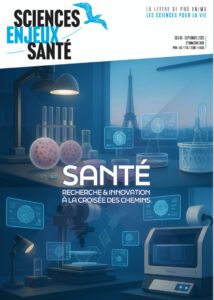
News on non-animal methods
NOVEMBER 10 - 14, 2025
NEWS, REPORTS & POSITION STATEMENTS
1. UK unveils its roadmap for alternative methods
In the UK, animal testing in science is set to be phased out faster under a new plan to deliver on the government’s manifesto commitment, unveiled by Science Minister Lord Vallance on November 11.
New £75 million funding will help bring forward new testing methods for products that can save lives and make the path to regulation clearer for researchers. The plan sets out specific commitments for the coming years (i.e., by 2027 researchers are expected to end tests of the strength of botox on mice), marking it out as one of the most detailed of its kind in the world and opening up new opportunities for the UK to lead on unearthing alternatives to phase out animal tests while growing its economy.
Read Prof Hartung comment on the roadmap
2. The need for a global effort to attend to human neural organoid and assembloid research
Human neural organoid and assembloid – the fusion of two organoids or more – research, unknown until a little more than a decade ago, has recently exploded. Although some of the ethical and social questions that arise have been previously discussed, these issues continue to grow and become more pressing.
In an opinion article published in the prestigious journal Science, the authors argue that there is a crucial need for a continuing international process to watch, and to guide, the progress of this field. Whether operationalized through existing organizations or a new one, this process would collect and disseminate evolving information about research involving human neural organoids, assembloids, and their transplantation into non-human animals ; promote discussion and engagement with associated ethics and policy issues among researchers and the public ; and offer guidance when needed.
Read the article (restricted access)
3. Chemicals : EU Parliament adopts simpler and more transparent assessment rules
In late October, as part of the 2020 EU Chemicals strategy for sustainability, the ‘one substance, one assessment’ package was adopted by the European Parliament. The package – that seeks to simplify and bring transparency to EU chemicals rules – consists of three proposals to streamline chemical safety assessments across EU legislation by improving the availability and accessibility of data relating to chemicals and maximising synergies between the EU agencies involved.
After the vote, rapporteur Dimitris Tsiodras (EPP, EL) said : “This is a significant step forward for EU chemicals policy. […] The common data platform will enhance transparency and trust, and streamline access to chemical data, enabling faster, science-based decisions while safeguarding data confidentiality and intellectual property rights. At the same time, we are reinforcing protection for citizens and the environment from hazardous chemicals and strengthening the EU’s leadership in sustainable chemicals management.”
INTERVIEWS, NOMINATIONS & AWARDS
4. A Reflection on the REACH Revision 2025 conference and the path forward
As President of SETAC Europe, Susana Loureiro from the University of Aveiro, had the privilege of participating in the landmark conference “REACH Revision 2025 : Simpler, Faster, Bolder”, held on 29 September in Brussels, Belgium. This pivotal event – co-organized by the Health and Environment Alliance (HEAL) and CHEM Trust – brought together a remarkable assembly of stakeholders to discuss the most significant revision of Europe’s flagship chemicals legislation in over a decade.
The event’s theme resonated strongly with the diverse audience of policymakers, industry representatives, environmental NGOs, civil society representatives and scientists. This triad of objectives summarizes the ambitious yet necessary transformation that REACH must undergo to address the 21st-century challenges while learning from nearly two decades of implementation experience.
5. Over €140 million awarded to turn visionary science into breakthrough innovation
The European Innovation Council (EIC) has announced the results of the 2025 EIC Pathfinder Open call, awarding over €140 million to visionary research projects developing radically new technologies with the potential to create future markets.
Examples of the selected projects include CEREBRIS, which tackles one of today’s most pressing health challenges : neurological disease. The project is developing a secure, federated, and explainable AI ecosystem for stroke care, capable of learning from diverse patient data such as brain scans, motion patterns, and neural signals. By enabling hospitals to collaborate without sharing raw data, CEREBRIS ensures privacy while improving diagnostics and rehabilitation outcomes.
TOOLS, PLATFORMS, CALLS
6. Complement-ARIE NAMs Reduction to Practice Challenge
Although many combinatorial New Approach Methodologies (NAMs) – combination and integration of multiple NAMs elements – are still early in development, not validated and standardized, nor available to the market broadly, it can potentially transform the way biomedical research, drug development, and clinical trials are conducted.
To accelerate the development and validation of combinatorial NAMs for human-based scientific and regulatory purposes, the NIH Common Fund’s Complement-ARIE program in collaboration with the FDA and EPA, is launching the Reduction to Practice Challenge. This challenge invites innovative combinatorial NAMs solutions that can successfully be implemented in a practical and usable form within a 3‑year period. Solvers will have the chance to win up to $1,430,000 in cumulative cash prizes and have their solution provided validation and/or qualification support by the Complement-ARIE Validation and Qualification Network. This Challenge is open to the public. The submission deadline is March 2, 2026.
Discover our new “Calls interface”
INDUSTRY, BIOTECH & PARTNERSHIPS
7. Case study : Enabling personalized therapy with PBPK modeling for pediatric epilepsy
GRIN-related disorders, first classified in 2010, are a family of rare, genetically defined pediatric neurodevelopmental disorders caused by mutations in “GRIN” genes causing disabilities that require constant supervision. With no FDA-approved therapies currently available, GRIN Therapeutics is on a mission to develop the first specific treatment for this neurodevelopmental disorder that targets the underlying disease pathophysiology.
In a previous collaboration with CERTARA, a PBPK model for radiprodil was developed to predict doses for infantile spasms, another form of severe epilepsy. This model was repurposed, to support the unique challenges of dosing infants with difficult to treat epilepsy syndrome. With the data provided by GRIN’s bioanalytical partners, Certara’s PBPK team performed the modeling in real time, providing each patient with a predicted dose for the next escalation in less than 24 hours. “This real-time, individualized approach enabled us to personalize dosing regimens to maximize the benefit-risk for patients while accelerating development.” said Michael Panzara, MD, MPH Chief Medical Officer, GRIN Therapeutics.
8. Using OOC technology to unlock patient-derived precision medicine
“Precision medicine” (also called personalized medicine) has become a guiding aspiration in healthcare : treating each person not as a generic patient, but based on their unique biology, disease subtype, and treatment responsiveness. In its ideal form, clinicians would know in advance which therapy will work — and which ones won’t — for a given patient, thereby improving outcomes and reducing unnecessary treatments and potential toxicity.
A recent blog on Emulate website explores how Organ-On-Chips (OOCs) are being used in personalized medicine, and then dive into three compelling case studies that illustrate how they are making a real-world difference.
SCIENTIFIC DISCOVERIES & PROTOCOLS
9. Canadian-led BRAIN Initiative completed the most comprehensive map of human brain cells
The Canadian-led BRAIN Initiative completed the most comprehensive map of human brain cells ever created, identifying 3,347 distinct cell types — tripling previous estimates. Using single-cell RNA sequencing on 1.2 million individual brain cells, researchers discovered the human brain is far more complex than any model predicted. This atlas is the “periodic table” of neuroscience — organizing the brain’s building blocks for the first time.
The mapping revealed that many newly discovered cell types are found only in humans, particularly in regions responsible for language, abstract thinking, and social cognition. This explains why mouse models often fail to predict human brain disorders. The data collected by the BICCN will now allow researchers to tackle fundamental scientific questions about the human brain and its genetic organization.
Read the bibliography in Science
10. AI tricks cancer stem cells into self-destruction to halve colon cancer deaths
Reactivating cancer cell lineage commitment to differentiate – and hence eliminate – cancer stem cells remains a therapeutic challenge.
University of California San Diego scientists have developed a machine learning tool called CANDiT (Cancer Associated Nodes for Differentiation Targeting) that reprograms cancer stem cells to self-destruct. The approach, published in Cell Reports Medicine, demonstrates potential to reduce the risk of recurrence and death in colon cancer by up to 50% in computer simulations across more than 2,100 patients.
11. Latest Cherry Biotech Organoid Digest
Here are the three standout papers featured in the latest edition of Cherry Biotech Organoid Digest Newsletter :
- A tumor-on-a-chip reveals how CAR‑T cells navigate and interact with solid tumor (Liu et al, Nature Biotechnology)
- Low oxygen, high impact : Hypoxia guides airway identity in the developing lung (Dong et al, Cell Stem Cell)
- Many ways to hide : Tumor subclones show distinct immune evasion strategies (Dijkstra et al, Cancer Cell)
WORTH (RE)SHARING
Can Europe future proof chemical testing and seize the shift away from animal models ?
Experts from Humane World for Animals, Cefic and the Dutch government debate whether the EU can build a future ready system that protects people and the environment while driving innovation and competitiveness.
Webinar : Applying the (Q)SAR Assessment Framework at ECHA
UPCOMING WEBINARS, WORKSHOPS, SYMPOSIA
Webinar : Why Ethics Matters in Human Stem Cell Research – Nov 29, 2025



